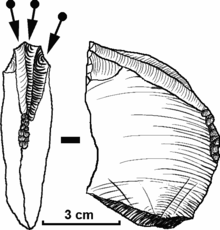Burin (archeology)

As stylus in archeology prehistoric be flint devices referred to in which rapidly resharpenable and stable cutting generated by narrow longitudinal reductions on the working edges. The first burins can be found in the Paleolithic , in larger quantities from the Upper Paleolithic and, with the blades, are one of the leading forms of the stone tool industry .
description
The burin is a tool with a short, fixed tip. It is scarfed or ungeschäftet to an area pulled upright. In the machining process, it was mainly used to make devices from ivory, antlers, wood or bone ( harpoons , needles , arrowheads ). In order to loosen chips from a relatively soft material, parallel grooves were cut, deepened and undermined until the chip could be loosened. During the Gravettian period , bones in particular were dissected in this way.
Burins were used for scraping, carving, cutting and engraving . Patterns were also engraved into various materials (e.g. in bones) with burins. For better guidance and to be able to exert more pressure, burins were perhaps shank with a round wooden handle, tubular bones or in antler cones. However, there is no evidence for such a shaft .
Due to the extensive engraving finds, one can conclude that there are numerous wooden objects that have not survived. The number of burins is in contrast to the number of antler and bone pieces found. It is therefore likely that the burins were mainly used to work on wooden objects. Graves often show no signs of use, as they have often been sharpened.
Technological classification
The middle graver is made from a blade using the burin technique: the point is created by 2 burin blows to the right and left of the central ridge, which then forms the point. With the side graver, the point is at one end of the cross-cutting edge. The goal of the production was, according to Stefan Unser, the statically unsurpassed middle graver. In his opinion, the other shapes represent unsuccessful pieces. Thick burins resemble long, thin core stones , are particularly solid and were later also made from core stones.
Graver as key forms
Some burins have a chronological guideline, as they only occur in certain cultures or phases of the Upper Palaeolithic.
- Arch graver
- Keel graver
- Vachons burin
- Noailles graver
- Ray's graver
- Corbiac stylus
- prismatic burin (made from a thick blade that is defined by several parallel and long burin paths)
- Cross stylus on hollow notch
- Lacam burin
- Parrot beak prick (cut with curved edge retouching, the tip of which is created by a hollow notch)
Two-point or retouched bay burins are multipurpose tools. Devices with burin function ends at both ends are referred to as double burins.
In the case of a burin from a cut, the shape of the tip is based on the more or less random shape of the cut and is not subject to any fixed rule (found in large numbers in the Danish Mesolithic ).
literature
- Rudolf Feustel : Technology of the Stone Age. Archaeolithic - Mesolithic. 2nd Edition. Böhlau, Weimar 1985 ( publications of the Museum for Pre- and Early History Thuringia 4, ISSN 0077-2291 ).
- Emil Hoffmann: Lexicon of the Stone Age. Beck, Munich 1999, ISBN 3-406-42125-3 ( Beck'sche series 1325).
- Silvia Tomášková: What Is a Burin? Typology, Technology, and Interregional Comparison. In: Journal of Archaeological Method and Theory. 12, 2, 2005, ISSN 1072-5369 , pp. 79-115, online at JSTOR .
Individual evidence
- ↑ Joachim Hahn : Recognizing and determining stone and bone artifacts. Introduction to artifact morphology. Institute for Prehistory and others, Tübingen 1991, ISBN 3-921618-31-2 , pp. 184f.
